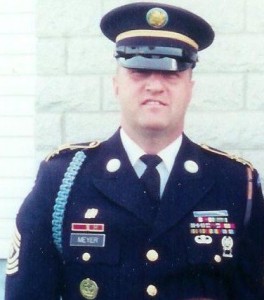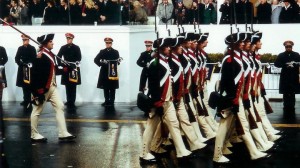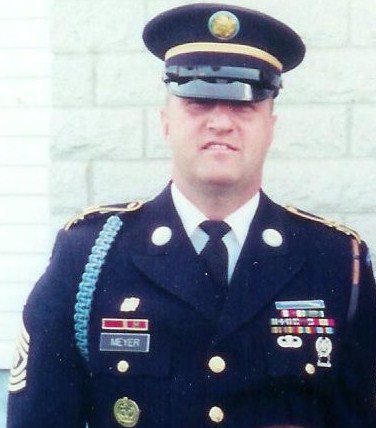
On September 11th, 2001, four planes were hijacked and used in multiple attacks: two on the World Trade Center towers in New York City, one on the Pentagon in Washington DC, and a fourth plane crashing in Pennsylvania. Sergeant Major Meyer from Alpena, Michigan was stationed at Fort McNair, Virginia and participated in the search and rescue operations after the attack on the Pentagon.
Sergeant Major Meyer is one of the current JROTC instructors at Hancock High School. Fort McNair is located just outside the south edge of Washington DC, next to Arlington National Cemetery and the Pentagon. While at Fort McNair, he was the First Sergeant of Alpha Company of the 1st Battalion, 3rd Infantry Regiment, commonly referred to as the Old Guard.
The Old Guard is the oldest active infantry unit in the U.S. military and is currently a ceremonial unit, which includes the U.S. Army Drill Team, the Continental Color Guard, and the Fife and Drum Corps. Part of the unit’s duties includes guarding the Tomb of the Unknown Soldier, doing funeral services in Arlington National Cemetery and appearing in parades, such as the presidential inauguration.

The first part of the September 11th was against the World Trade Center. 30 minutes after the Twin Towers were hit, American Airlines Flight 77, which had originally left Dulles Airport for Los Angeles, California, hit the western face of the Pentagon, killing everyone aboard the flight and 125 of the estimated 2,600 Pentagon personnel near the crash. The plane only caused damage to west wing and hit the building in-between the two corridors that ran from the front of the building to the middle courtyard. The plane “penetrated the E ring (outermost) midway between corridors 4 and 5 as shown below. It then traveled through the D ring and into the C ring [9.].” However, the damage also ignited fires and toxic gas on some of the floors in the outermost corridors of the five story building.
The September 11th attack was a surprise to everyone, which caused a number of reactions. Those trying to rationalize the attack would compare it to the Pearl Harbor attack in the 1940s, “figuring the event within some more generalized tradition of terrorism or aggression toward the American people [7. p. 86].” Others would volunteer in some compacity with “people living close to disasters have an increased chance of knowing people who were injured, killed, or in danger, which should increase the probability of participating in relief efforts [5. p. 194].” Shortly after the Pentagon was evacuated, the Arlington County Fire Department, District of Columbia Fire and EMS Departments arrived on scene followed by other fire departments as well as volunteers. Sergeant Major Meyer remembered that they were given a choice, that they were allowed to not participate in the cleanup it they thought it was too much. Only one person sat out the first day, but then returned after, as they wanted to be there to pay their respects.
Early on the morning of the attack, 1SG Meyer and alpha company were doing PT on Ft. McNair. When they had finished, they had a formation and were then sent over to Ft. Myer to practice for Spirit of America, a show where they acted out various points in American history, ranging from western expansion to the Civil War and World War II. 1SG Meyer was on the way over to meet with his company at Ft. Myer when he saw the Twin Tower attacks on a TV in an officer’s room.
On the way to Ft. Myer, 1SG Meyer could see the smoke coming from the Pentagon. He then decided to try to call Mrs. Meyer, his wife, but the phones were overloaded. Unaware to him, Mrs. Meyer had also been on the way to Ft. Myer for the practice, but had turned around after witnessing the plane hitting the Pentagon in order to return to Fr. Belvoir to take care of their children and to not get stuck when they locked down the area.

After arriving at Ft. Myer, 1SG Meyer and his company waited until he called the busses to come, pick them up, and take them back to Ft. McNair. Once the busses arrived, they grabbed their gear from practice and loaded the busses. The busses took the quickest way to the site, which involved cutting through Arlington National Cemetery. As they passed through, they could see the Pentagon. Everyone looked, but no one talked, each person thinking about someone they might have known that was in the building, as well as two of the men from the company that had been there when it was hit.
As they continued to Ft. McNair, they reached Memorial Bridge. However the busses had to stop as it was blocked off by police. 1SG Meyer stepped off the bus and conferred with the officers on scene. There was an abandoned car on the bridge with a bunch of boxes in it. The police thought that there was a bomb in the car and had blocked the bridge as a precaution. Later be revealed that there was no bomb and just boxes. 1SG Meyer explained to the police that they needed to return to Ft. McNair and they said that they could cross if he took responsibility if anything happened. He returned to the busses and conferred with the Lieutenants, then told the bus drivers to cross as fast as they could. Once across, they continued to make their way to Ft. McNair, but were stopped about a half mile away from the base. Since they were still in the PT gear, they left a few people to guard the gear on the busses and ran the last half mile.
Once on base, 1SG Meyer waited with the company commander. He began thinking “Who could have done this? Why? This doesn’t just happen, this is America [2.].” In the early afternoon, they received orders to take over the search and rescue operations during the night. In addition, one of their four platoons would be left at base in order to guard it. He then called Mrs. Meyer to let her know what was going on and to tell the other wives of men from the company. This is because Mrs. Meyer was the leader of the support group on Ft. Belvoir, and was responsible for calling the others in order to check up on them or to relay information or helped put together care packages with toiletries.
At Ft. McNair, the company was allowed to rest for the day until 4:00 pm, when they left to go to the Pentagon. The company, now in full BDUs (battle dress uniform) filled a small convoy of deuce-and-a-halves (2.5 trucks) and Humvees. On the way there, people were flying flags, waving at the convoy, and even honking their horns in support. Once there, 1SG Meyer was shown where the plane hit by the Sergeant Major. He returned to the company and they broke up into their platoons.
One platoon stayed outside and sifted through what was brought out placing objects into three piles, personal items, classified materials, and money, particularly coins. The other two platoons went inside to begin search and rescue. In addition, they also posted guards in the Pentagon to keep people from the other wings entering the destroyed wing. However, their time was cut short and they had to pull back across the highway, as the building shifted and some of the floors collapsed. 1SG Meyer then called Mrs. Meyer so that she could notify the wives that everyone was okay before they heard about the collapse on the news. In the morning they out-briefed and headed back to the barracks to rest until their next shift.
The site at the Pentagon was under control of the FBI, which at one point requisite 64 biohazard bags for found body parts. These bags were then labeled and had a foul stench. The inside of the Pentagon was completely black and some spots were flooded with water that was contaminated by jet fuel and bodily fluids. Because everything was black, the soldiers had an interesting way to order to check to see if something was a body part. “Because everything was black, we had to try to break whatever we found open. If it pulled apart, it was a body part, which looked like a burnt pot roast once we broke it [2.].”
The following days went similar to the first, they would arrive at 4, work through the night, out-brief, then return to the barracks to rest. However, they did rotate the platoons each day. On one of the days, someone found 2 $20 bills, which 1SG Meyer stuck into one of the certificates in the personal items pile. On another day, it was mentioned by the officer in the out-briefing that someone had found what was believed to be one of the wallets of one of the terrorists.
On the second day, they were required to put on hazmat boots when entering the site, while on the third or fourth day they had to wear a full white hazmat suit over their BDUs, which was hot on the inside. This is because U.S. Navy Industrial Hygienists deemed that the “contaminants included byproducts of combustion, lead, asbestos and other toxins [6].” These Industrial Hygienists tested and assessed the damaged areas for health risks in order to protect those involved with the recovery efforts.
Also on the second day, tents were set up outside so that people could rest. In addition, local restaurant chains, the Salvation Army, and the Red Cross had also set up to feed those on site free of charge. On the fourth day they were allowed to go back home after their shifts. The next day they were advised to take a shower and place their clothes in a bag before returning home, as dogs could smell the bodies from the Pentagon off of them. The soldiers retuning could also smell the bodies in the Pentagon when approaching, a smell that was described as the smell of death. They were also advised to watch what they talked about, as certain things, like how to check for body parts, might be too sensitive at that point in time. On the other side, the support group advised the wives to not ask too many questions about the Pentagon and that the soldiers would be ready to talk about it when they were ready.
After a few more days, they were allowed 2 days off. On the first, their son forgot something at home. Both 1SG and Mrs. Meyer went to the school to drop it off for him. On the way, they followed a school bus and saw that the MPs were getting on the bus and checking it while holding a rifle, but only had a pistol when checking civilian vehicles. When they got to the gate, he asked to see the MP’s 1st Sergeant. He then explained to him that it didn’t make sense, as the kids coming from on base were less of a threat than the civilian cars. When they arrived at the school, there was no-one there. They found out that there had been a bomb threat against the school and that the kids were Mt. Vernon High School. On the way to pick up their son and daughter, Mrs. Meyer notified the other parents of the situation. On the second day, the company buried the body of a general who had died in the pentagon in Arlington, as it was part of their job in the Old Guard.

The searching lasted for 2 more weeks, though they were still finding body parts on the last night. At the time 1SG Meyer didn’t know how they cleaned up the Pentagon, but he did see them bring in Bobcat bulldozers. The soldiers that searched for in the Pentagon were focused on their duty. They wanted to be there, to pay their respects. When they were finished in the Pentagon, they began the funeral services for the victims in Arlington. These funeral services took place on Saturdays, while normal funeral services took place during the week. After the search, he also had to be debriefed, get a hepatitis shot, and was interviewed by the Army Historian. His last mission with the Old Guard before being assigned to West Point was the last funeral, a funeral for a Sergeant Majors, where he passed the flag off to the Sergeant Major of the Army, who then passed 3 flags to the family.
One month later, 1SG Meyer was approached and was offered for his company to take down the flag on the Pentagon, which he accepted. 1SG Meyer and two others went to the top of the Pentagon to see how they would take the flag down. They decided that 4 soldiers would stand on the roof of the Pentagon and lower the large flag down. The rest of the company would stand below and ceremoniously catch the flag as it was lowered, then fold the flag. After the flag was folded, it was put in to the back of a car. It would later be put on display at the Smithsonian Institution until being returned to Ft. McNair.
Primary Sources:
- Meyer, Lisa. 2016, November 14. Personal Interview.
- Meyer, Randal. 2016, November 14. Personal Interview.
- Meyer, Randal. “Company Guidon.” November 1, 2001. Artifact.
- “About the 3d U.S. Infantry Regiment.” Army.mil. U.S. Army. (2016).
- Beyerlein, Kraig, and David Sikkink. “Sorrow and Solidarity: Why Americans Volunteered for 9/11 Relief Efforts.” Social Problems 55.2: 190-215. (2008).
- “Industrial hygienists clear the air after Pentagon terrorist attack.” Navy Safety Center. U.S. Navy. (August, 22 2014).
- Leach, Neil. “9/11.” Diacritics 33.3/4: 75-92. (2003).
- NMAH. “You asked, we answer: What happened to the Pentagon flag from September 11, 2001?” Smithsonian. Smithsonian Institute. (October 21, 2010).
- Roberts, Brian J. “The September 11th Attack on the Pentagon.” The September 11th Attack on the Pentagon. Brian J. Roberts. (2001).
- “September 11 attacks.” Wikipedia. Wikimedia Foundation Inc. (2006).
- “The Pentagon.” Wikipedia. Wikimedia Foundation Inc. (2006).

